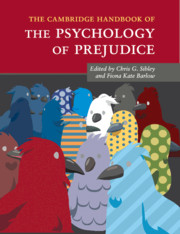Book contents
- Frontmatter
- Dedication
- Contents
- List of Figures
- List of Tables
- Notes on the Contributors
- Part I General Theoretical Perspectives
- 1 An Introduction to the Psychology of Prejudice
- 2 Evolutionary Approaches to Stereotyping and Prejudice
- 3 From Prejudice to Social Change: A Social Identity Perspective
- 4 Ingroup Projection as a Challenge of Diversity: Consensus about and Complexity of Superordinate Categories
- 5 Intergroup Discrimination: Ingroup Love or Outgroup Hate?
- 6 Intergroup Emotions Theory: Prejudice and Differentiated Emotional Reactions toward Outgroups
- 7 Intergroup Threats
- 8 Social Dominance Theory: Explorations in the Psychology of Oppression
- 9 The Dual Process Motivational Model of Ideology and Prejudice
- 10 Is Prejudice Heritable? Evidence from Twin Studies
- Part II Prejudice in Specific Domains
- Part III Prejudice Reduction and Analysis in Applied Contexts
- Index
- References
3 - From Prejudice to Social Change: A Social Identity Perspective
from Part I - General Theoretical Perspectives
Published online by Cambridge University Press: 17 November 2016
- Frontmatter
- Dedication
- Contents
- List of Figures
- List of Tables
- Notes on the Contributors
- Part I General Theoretical Perspectives
- 1 An Introduction to the Psychology of Prejudice
- 2 Evolutionary Approaches to Stereotyping and Prejudice
- 3 From Prejudice to Social Change: A Social Identity Perspective
- 4 Ingroup Projection as a Challenge of Diversity: Consensus about and Complexity of Superordinate Categories
- 5 Intergroup Discrimination: Ingroup Love or Outgroup Hate?
- 6 Intergroup Emotions Theory: Prejudice and Differentiated Emotional Reactions toward Outgroups
- 7 Intergroup Threats
- 8 Social Dominance Theory: Explorations in the Psychology of Oppression
- 9 The Dual Process Motivational Model of Ideology and Prejudice
- 10 Is Prejudice Heritable? Evidence from Twin Studies
- Part II Prejudice in Specific Domains
- Part III Prejudice Reduction and Analysis in Applied Contexts
- Index
- References
Summary
For more than 80 years, understanding the causes, consequences, and remedies for prejudice has been a central theme in social psychology. Prejudice, by definition, refers to the holding of negative attitudes toward others based exclusively on their membership of a given group (Brown, 1995, p. 6). Prejudice is a major area of academic enquiry because it is considered a necessary condition for discrimination, which affects the opportunities and well-being of its targets – the victims. Furthermore, when negative views about a particular group become widespread and shared, then intergroup conflict, violence, and civil unrest are more likely.
Much of social psychology, though, has focused on the concepts of prejudice and social change as largely distinct areas of inquiry underpinned by different levels of analysis. Many approaches to explaining prejudice are directed at individual-level factors such as personality and cognitive and motivation processes (which are potentially faulty and irrational). Other explanations of prejudice emphasize the role of system-level factors and argue that maintenance of the status quo and preservation of stable social hierarchies consequently result in the subjugation of particular minority groups. An alternative analysis is that prejudice and social change are both outcomes of ongoing and fluid intergroup relations whereby people's group memberships and relationships between groups play a central explanatory role. The overarching and fundamental questions of interest within this trajectory of work are how is the intergroup relationship perceived now and when and how does it change.
Drawing on the social identity perspective, which incorporates both social identity theory (Tajfel & Turner, 1979) and self-categorization theory (Turner, Hogg, Oakes, Reicher, & Wetherell, 1987), the aim of this chapter is to make a case for the interdependence of prejudice and social change. This more integrated analysis relies on a new understanding of prejudice that rejects the premise that such attitudes and associated negative treatment are the product of flawed and faulty cognitive and motivational psychological processes (Oakes, Haslam, & Turner, 1994; Reynolds, Haslam, & Turner, 2012). Instead prejudice needs to be conceptualized, first and foremost, as an outcome of group processes and intergroup dynamics, whereby members of the majority and minority groups are positioned in a particular social relationship. Majority and minority do not refer to the simple numbers but to positions of power through cultural and economic dominance within a social system.
- Type
- Chapter
- Information
- The Cambridge Handbook of the Psychology of Prejudice , pp. 47 - 64Publisher: Cambridge University PressPrint publication year: 2016
References
- 4
- Cited by



